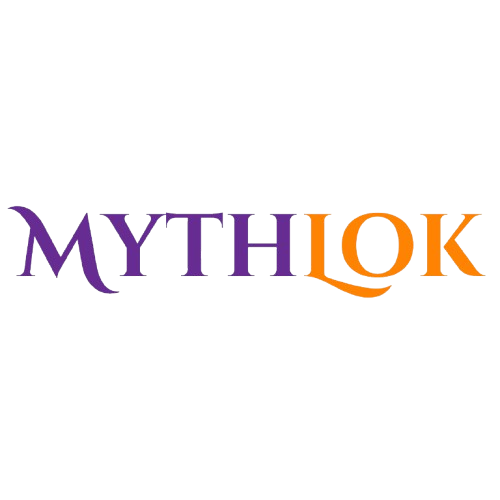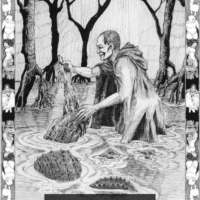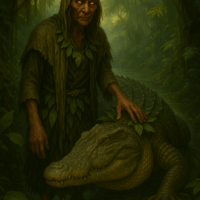Agalon Hayopan : The Beast Master
Listen
At a glance
| Description | |
|---|---|
| Origin | Philippine Mythology |
| Classification | Spirits |
| Family Members | N/A |
| Region | Philippines |
| Associated With | Crocodiles |
Agalon Hayopan
Introduction
In the expansive realm of Philippine mythology, the Agalon Hayopan emerges as a haunting figure steeped in both terror and respect. Originating from the Bicolano belief system, this being is a unique type of aswang, a class of shape-shifting monsters feared across the archipelago. However, unlike most aswangs that fly through the night or seduce their victims, the Agalon Hayopan exhibits an unsettling patience and control. This entity commands crocodiles—creatures already feared in the Philippine wetlands—turning them into deadly accomplices. The legend reflects a cultural reverence for nature’s might and mystery, particularly in regions where rivers and swamps are integral to daily life.
Physical Traits
While detailed physical depictions of the Agalon Hayopan are scarce, the entity is generally imagined as a reclusive, humanoid figure cloaked in shadow and mystery. Typically taking the form of an elderly man or woman, the Agalon Hayopan often appears unassuming, blending in with villagers by day.
At night, however, subtle transformations hint at its true nature. Glowing eyes, elongated nails, or a feral gait may betray its monstrous essence. The environment it inhabits—dense mangroves, murky riversides, and mist-covered swamps—further adds to its spectral image. But the true terror doesn’t lie in its appearance—it lies in the silent, watchful crocodiles it raises from birth. These beasts are larger, eerily perceptive, and more aggressive than any naturally occurring species, often described with a sinister intelligence that reflects their master’s will.
Family
Unlike many mythological beings who have human kin or romantic entanglements, the Agalon Hayopan forges its familial bonds with the animal kingdom. The crocodiles it raises are more than tools or pets; they are cherished companions, nurtured from hatchlings and trained to respond with near-human loyalty.
In some versions of the myth, the relationship between the Agalon Hayopan and its crocodiles is so deep that the animals mourn—or even enact vengeance—upon their master’s death. These bonds often stretch across generations, with young aswangs inheriting not just knowledge but also the trained crocodiles of their predecessors. This tradition underscores a unique family structure centered not around bloodlines, but around ritual, mentorship, and the shared purpose of survival through predation.
Other names
The term Agalon Hayopan comes from the Bicolano language—agalon meaning “lord” or “master,” and hayopan meaning “animal” or “beast.” Together, the name literally translates to “Master of Beasts,” emphasizing the entity’s dominance over its animal allies.
In some regions, especially among Ilonggo and other Visayan groups, it is alternatively referred to as Saropan, a variation reflecting the diverse dialects and interpretations across the Philippines. Despite these differences, the central theme remains consistent: this creature does not hunt alone—it commands. These names are not just labels but encapsulate the being’s essence, signaling its unique place within the broader aswang taxonomy.
Powers and Abilities
What sets the Agalon Hayopan apart from other mythical beings is not brute strength or magical prowess, but strategic mastery and deep animal kinship. Its primary gift is the ability to control and communicate with crocodiles, turning them into instruments of death.
Rather than risking exposure by attacking humans itself, it deploys these crocodiles to do the hunting—dragging unsuspecting victims into rivers or even sneaking into homes near water bodies. These crocodiles are said to possess heightened senses, enabling them to locate human targets from great distances and carry out coordinated attacks.
Unlike other aswangs who engage in terrifying transformations or sky-bound flights, the Agalon Hayopan relies on patience, planning, and the unique intelligence of its animal companions. This indirect method of predation has earned it the label of being the “laziest” type of aswang—but this laziness is strategic rather than sluggish, rooted in manipulation and foresight.
Modern Day Influence
Though lesser-known outside the Bicol region, the Agalon Hayopan has found renewed life in contemporary Philippine culture. It surfaces in horror stories, animation, and local YouTube series such as Mga Kwento ni Thelmo, where its eerie legend is retold for new generations. With the rise of folklore-focused platforms like The Aswang Project and digital comics inspired by Philippine myths, this elusive creature is slowly reclaiming its place in the national narrative.
In symbolic terms, some modern interpreters see the Agalon Hayopan as a representation of ecological guardianship. The relationship between the entity and its crocodiles highlights a bond with nature often ignored or misunderstood. In this light, the creature can be read not just as a monster but as a cautionary emblem—warning of the consequences when humans disrupt natural habitats.
Additionally, the myth plays a role in shaping regional identity. For many Bicolanos, tales of the Agalon Hayopan aren’t just scary stories—they are part of cultural memory, oral history, and local pride. These stories provide a link to ancestors, traditions, and the landscapes that birthed them.
The influence also extends to modern entertainment. Myth-inspired shows like Trese have set a precedent for incorporating such folklore into mainstream narratives, and it’s likely that beings like the Agalon Hayopan will continue to inspire characters in horror films, video games, and speculative fiction. As Philippine mythology gains global traction, this crocodile master may yet rise from the shadows into broader recognition.
Related Images
Source
Gaverza, K. (2018, January 1). Agalon Hayopan – Philippine Spirits. https://phspirits.com/agalon-hayopan/
Philippine Spirits. (2025, May 28). Agalon Hayopan 2 – Philippine Spirits. https://phspirits.com/agalon-hayopan-2/
Steemit. (n.d.). Philippine Folklore † AGALON HAYOPAN. https://steemit.com/philippines/@leviathan101/philippine-folklore-agalon-hayopan
Stoic Aswang. (2015, December 23). Monsters & other supernatural beings from Filipino folklore & myths. https://stoicaswang.wordpress.com/2015/12/23/supernatural-beings-and-creatures-of-philippine-folklore-and-mythology/
The Aswang Project. (2016, February 8). Bicolano Pantheon of Deities and Creatures | Philippine Mythology. https://www.aswangproject.com/bikolano-deities-in-philippine-mythology/
Jocano, F. L. (1978). Towards an understanding of Philippine myths. https://www.jstor.org/stable/29792131
Frequently Asked Questions
What is lorem Ipsum?
I am text block. Click edit button to change this text. Lorem ipsum dolor sit amet, consectetur adipiscing elit. Ut elit tellus, luctus nec ullamcorper mattis, pulvinar dapibus leo.
What is lorem Ipsum?
I am text block. Click edit button to change this text. Lorem ipsum dolor sit amet, consectetur adipiscing elit. Ut elit tellus, luctus nec ullamcorper mattis, pulvinar dapibus leo.
What is lorem Ipsum?
I am text block. Click edit button to change this text. Lorem ipsum dolor sit amet, consectetur adipiscing elit. Ut elit tellus, luctus nec ullamcorper mattis, pulvinar dapibus leo.
What is lorem Ipsum?
I am text block. Click edit button to change this text. Lorem ipsum dolor sit amet, consectetur adipiscing elit. Ut elit tellus, luctus nec ullamcorper mattis, pulvinar dapibus leo.
What is lorem Ipsum?
I am text block. Click edit button to change this text. Lorem ipsum dolor sit amet, consectetur adipiscing elit. Ut elit tellus, luctus nec ullamcorper mattis, pulvinar dapibus leo.








